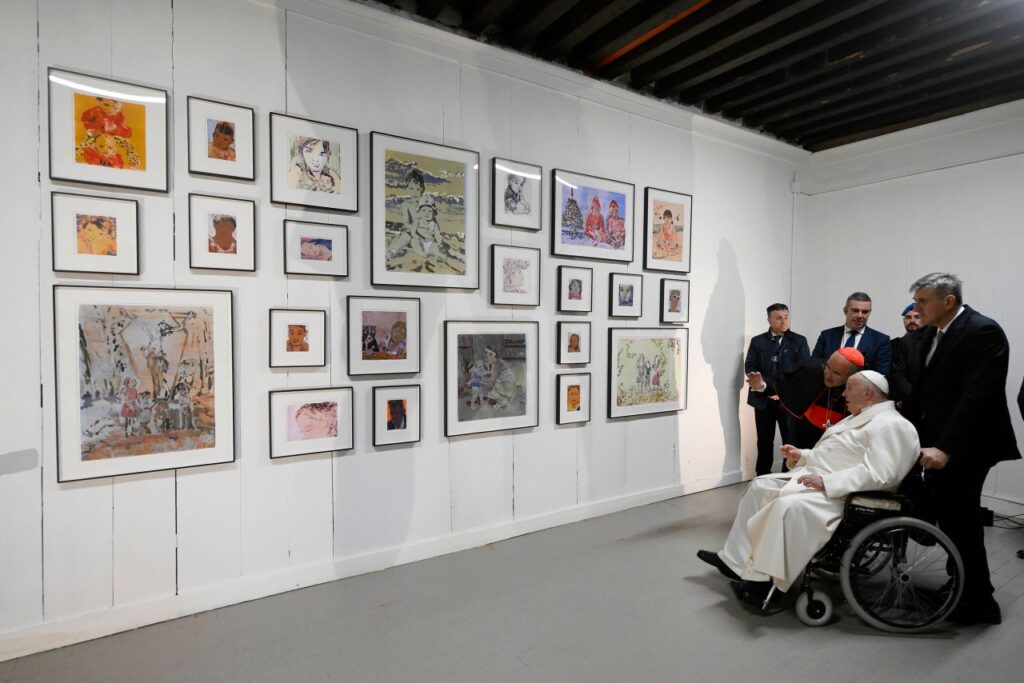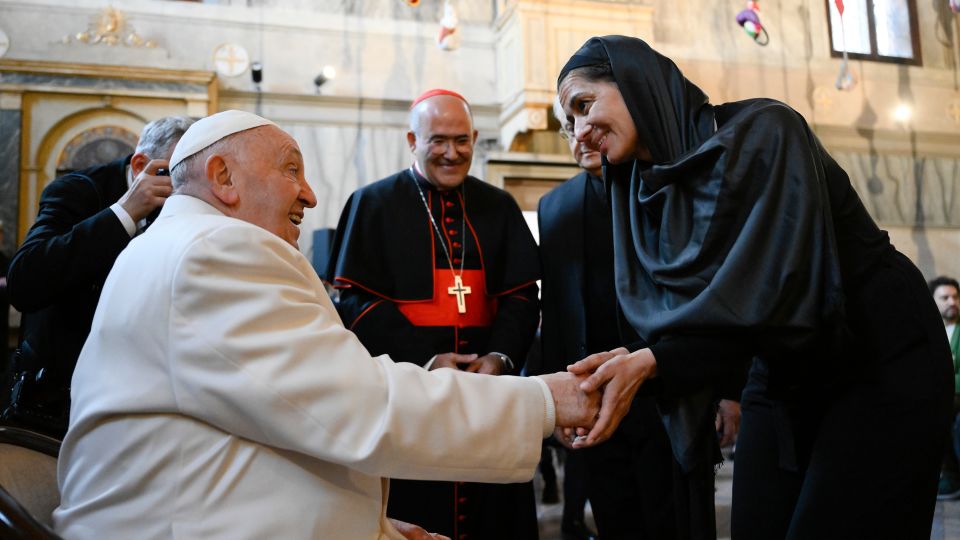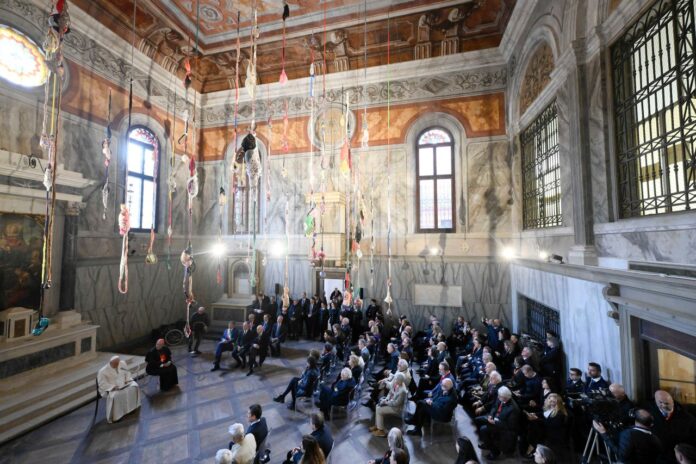In a historic visit, Pope Francis became the first pontiff to attend the Venice Biennale, a renowned contemporary art festival. The trip, which took place on April 28, also included a visit to a female prison and aimed to rehabilitate the reputation of a pioneering American nun artist.
During his visit to the female prison on Giudecca Island, Pope Francis made a powerful statement about his concern for society’s outsiders, particularly prisoners. The Holy See’s takeover of the prison for the Biennale exhibition was a symbolic gesture, highlighting the Pope’s commitment to addressing the issues faced by those who are often marginalized and forgotten.
As he arrived by helicopter, the Pope’s presence brought a sense of hope and compassion to the inmates. In the courtyard, he took the time to personally greet each of the approximately 80 women, acknowledging their humanity and showing them that they are not alone. This act of kindness and connection was a reminder that everyone, regardless of their circumstances, deserves to be treated with dignity and respect.
Inside the prison, the exhibition titled “Con I Miei Occhi” (With My Eyes) showcased the works of several female artists. These artists, some of whom were inmates themselves, used their creativity to express their experiences and shed light on the challenges faced by prisoners. The prison walls were adorned with poetry written by the inmates, giving them a voice and allowing their stories to be heard.
One of the highlights of the exhibition was a short film directed by Italian director Marco Perego and his wife, actor Zoe Saldana. The film depicted the journey of a prisoner on the day of her release, with Saldana herself portraying the role. This powerful portrayal served as a reminder of the struggles faced by those reentering society and the need for support and understanding during this transition.
In a meeting with the artists involved in the Biennale and the Holy See pavilion, Pope Francis emphasized the importance of their work in addressing societal issues. He recognized that artists have a unique ability to challenge the status quo and provoke thought and reflection. The Pope highlighted the need to confront issues such as racism, xenophobia, ecological imbalance, fear of the poor, and inequality, and he commended the artists for their contributions to these important conversations.
By visiting the female prison and engaging with the inmates and artists, Pope Francis sent a powerful message of compassion, empathy, and solidarity. He reminded us of the importance of recognizing the humanity in every individual, regardless of their past mistakes or current circumstances. The visit served as a call to action, urging society to address the systemic issues that contribute to the marginalization of certain groups and to work towards a more inclusive and just world.

Art as a Catalyst for Change
The Pope’s visit to the Venice Biennale highlights the transformative power of art. Through their creative expressions, artists have the ability to bring attention to pressing social issues and inspire change. Art has the potential to challenge societal norms, provoke thought, and foster empathy.
By focusing on society’s outsiders, particularly prisoners, the “Con I Miei Occhi” pavilion sheds light on the experiences and stories of those often marginalized and forgotten. The inclusion of works from female artists further amplifies the voices of women in the art world, who have historically been underrepresented.
Pope Francis recognizes the potential of art to bridge divides and promote dialogue. By engaging with the artists and their works, he acknowledges their role in addressing pressing global challenges. The Pope’s message emphasizes the need for artists to use their talents to promote inclusivity, justice, and compassion.
Art has always had the power to provoke thought and challenge societal norms. Throughout history, artists have used their creative expressions to shed light on the injustices and inequalities that exist in the world. From Picasso’s “Guernica,” which depicted the horrors of war, to Banksy’s thought-provoking street art, which critiques capitalism and social inequality, art has been a powerful tool for social commentary and change.
Moreover, art has the unique ability to evoke empathy in its audience. Through visual representations, music, and performance, artists can make us feel and understand the experiences of others. This emotional connection can inspire individuals to take action and work towards a more just and compassionate society.
The “Con I Miei Occhi” pavilion at the Venice Biennale exemplifies the power of art to bring attention to marginalized communities. By showcasing the works of prisoners, the pavilion challenges society’s perception of these individuals and humanizes their experiences. Through their art, prisoners are given a platform to express themselves and share their stories, breaking down the barriers that often separate them from society.
Furthermore, the inclusion of female artists in the pavilion is a significant step towards gender equality in the art world. Women have long been underrepresented and undervalued in the arts, and their voices and perspectives have been overlooked. By featuring their works alongside those of their male counterparts, the pavilion not only amplifies the voices of women but also challenges the patriarchal structures that have historically dominated the art industry.
Pope Francis’ visit to the Venice Biennale sends a powerful message about the importance of art in addressing global challenges. By engaging with the artists and their works, the Pope acknowledges their role as catalysts for change. He recognizes that art has the potential to bridge divides, promote dialogue, and inspire individuals to work towards a more inclusive and compassionate world.
Art as a Healing and Transformative Process

The Pope’s visit to the female prison underscores the transformative power of art within the context of rehabilitation. He acknowledges that a stay in prison can mark the beginning of something new, symbolized by the artistic event hosted within the prison walls.
Art has the ability to heal wounds and facilitate personal growth. Through creative expression, individuals can find solace, explore their emotions, and gain a sense of purpose. The poetry displayed on the prison walls serves as a testament to the power of artistic expression in the process of healing and self-discovery.
Art therapy, in particular, has been recognized as an effective tool in helping individuals cope with trauma, addiction, and mental health issues. By engaging in various art forms such as painting, drawing, writing, or music, individuals can tap into their innermost thoughts and feelings, allowing for a cathartic release and a deeper understanding of themselves.
Moreover, art provides a platform for individuals to communicate their experiences and perspectives to others. In the case of the female prison, the poetry displayed on the walls not only serves as a means of personal expression but also invites dialogue and empathy from those who view it. This exchange of emotions and ideas can foster a sense of connection and understanding, breaking down barriers and stereotypes.
Pope Francis reminds us that forgiveness and healing are universal needs. He acknowledges his own imperfections and emphasizes the importance of extending compassion and understanding to others, regardless of their past mistakes. By meeting with the artists and inmates, the Pope demonstrates his commitment to promoting a culture of forgiveness and second chances.

